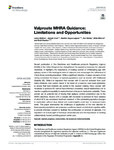Valproate MHRA Guidance: Limitations and Opportunities
| dc.contributor.author | Watkins, L | |
| dc.contributor.author | Cock, H | |
| dc.contributor.author | Angus-Leppan, H | |
| dc.contributor.author | Morley, K | |
| dc.contributor.author | Wilcock, M | |
| dc.contributor.author | Shankar, Rohit | |
| dc.date.accessioned | 2021-05-23T10:46:18Z | |
| dc.date.issued | 2019-02-20 | |
| dc.identifier.issn | 1664-2295 | |
| dc.identifier.issn | 1664-2295 | |
| dc.identifier.other | ARTN 139 | |
| dc.identifier.uri | http://hdl.handle.net/10026.1/17192 | |
| dc.description.abstract |
Recent publication of the Medicines and Healthcare products Regulatory Agency (MHRA) in the United Kingdom has strengthened the regulatory measures for valproate medicines. It highlights the importance of making women of childbearing age with epilepsy aware of the teratogenic risks of valproate and encourages the withdrawal of it from those currently prescribed. While a significant directive, it raises concerns of not having considered the impact on special populations such as women with Intellectual Disability (ID). While it is important that women with ID are not excluded from such safety initiatives, due caution needs to be taken on a case by case basis preferably, to ensure their best interests are central to the decision making. Many women with moderate to profound ID cannot have informed consented sexual relationships not to mention cognitive incapability to make informed choices on medication suitability. These women are at potential risk of having their epilepsy control undermined due to the MHRA directives. Around 30% of people with moderate to profound ID have seizures of which 60% are considered treatment resistant. In this vulnerable population changes to medication without clear clinical and social insights could lead to increased harm levels. This paper enumerates the challenges of application of the new directive to these special populations and proposes a pathway based on individual cognitive ability to provide informed consent to facilitate the continuation or removal of valproate. It is important not to lose sight of individual circumstances and the importance of working collaboratively toward providing person center care. | |
| dc.format.extent | 139- | |
| dc.format.medium | Electronic-eCollection | |
| dc.language | eng | |
| dc.language.iso | eng | |
| dc.publisher | Frontiers Media SA | |
| dc.rights | Attribution-NonCommercial-NoDerivatives 4.0 International | |
| dc.rights | Attribution-NonCommercial-NoDerivatives 4.0 International | |
| dc.rights | Attribution-NonCommercial-NoDerivatives 4.0 International | |
| dc.rights | Attribution-NonCommercial-NoDerivatives 4.0 International | |
| dc.rights.uri | http://creativecommons.org/licenses/by-nc-nd/4.0/ | |
| dc.rights.uri | http://creativecommons.org/licenses/by-nc-nd/4.0/ | |
| dc.rights.uri | http://creativecommons.org/licenses/by-nc-nd/4.0/ | |
| dc.rights.uri | http://creativecommons.org/licenses/by-nc-nd/4.0/ | |
| dc.subject | valproate | |
| dc.subject | pregnancy | |
| dc.subject | communication | |
| dc.subject | risk assessment | |
| dc.subject | intellectual disability | |
| dc.title | Valproate MHRA Guidance: Limitations and Opportunities | |
| dc.type | journal-article | |
| dc.type | Journal Article | |
| plymouth.author-url | https://www.webofscience.com/api/gateway?GWVersion=2&SrcApp=PARTNER_APP&SrcAuth=LinksAMR&KeyUT=WOS:000459145000001&DestLinkType=FullRecord&DestApp=ALL_WOS&UsrCustomerID=11bb513d99f797142bcfeffcc58ea008 | |
| plymouth.issue | FEB | |
| plymouth.volume | 10 | |
| plymouth.publication-status | Published online | |
| plymouth.journal | Frontiers in Neurology | |
| dc.identifier.doi | 10.3389/fneur.2019.00139 | |
| plymouth.organisational-group | /Plymouth | |
| plymouth.organisational-group | /Plymouth/Faculty of Health | |
| plymouth.organisational-group | /Plymouth/Users by role | |
| dc.publisher.place | Switzerland | |
| dcterms.dateAccepted | 2019-02-04 | |
| dc.rights.embargodate | 2024-01-03 | |
| dc.identifier.eissn | 1664-2295 | |
| rioxxterms.versionofrecord | 10.3389/fneur.2019.00139 | |
| rioxxterms.licenseref.uri | http://creativecommons.org/licenses/by-nc-nd/4.0/ | |
| rioxxterms.licenseref.startdate | 2019 | |
| rioxxterms.type | Journal Article/Review |



